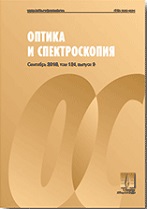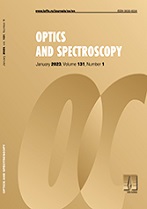|
Optics of low-dimensional structures, mesostructures, and metamaterials
Photoluminescence of Zn$_{1-x-y}$Cu$_{x}$Eu$_{y}$S/EuL$_{3}$ quantum dots in a polyacrylate matrix
V. P. Smagina, A. A. Isaevaa, N. S. Ereminab
a Altai State University, Barnaul
b Tomsk State University
Abstract:
Zinc sulfide is one of the most popular luminescent semiconductors of group A(II)B(VI). Doping ZnS quantum dots with Ln$^{3+}$ ions makes it possible to form nanoscale structures in a semiconductor matrix containing isolated centers of narrow-band luminescence. The introduction of quantum dots into the acrylate matrix further stabilizes the particles and allows them to form their morphology. Nanoscale structures of Zn$_{1-x-y}$Cu$_{x}$Eu$_{y}$S/EuL$_{3}$, where L – trifluoroacetate are anions, were synthesized by the method of emerging reagents in situ in the medium of methyl methacrylate (MMA). ZnS doping was performed by simultaneous introduction of soluble precursors of zinc sulfide, as well as copper and europium trifluoroacetates into the acrylate reaction mixture. Polymer optically transparent compositions of PMMA/Zn$_{1-x-y}$Cu$_{x}$Eu$_{y}$S/EuL$_{3}$ were obtained by radical polymerization of MMA in the block. The excitation of luminescence of compositions is associated with Interzone electron transitions in ZnS, with a system of levels that form alloying ions in the forbidden zone of ZnS, as well as with their own energy absorption by Eu$^{3+}$ ions. Broadband luminescence of compositions is caused by intracrystalline defects formed in ZnS during doping. Narrow-band luminescence occurs as a result OF $^{5}D_{0}\to{}^{7}F_{j}$ electronic transitions in Eu$^{3+}$ ions associated with quantum dots, as well as being in the polymer matrix independently of them. The transfer of energy from the donor levels of the semiconductor matrix to the levels of Eu$^{3+}$ ions, followed by its release in the form of luminescence, was confirmed by the imposition of absorption bands doped with ZnS and excitation bands of luminescence compositions, as well as an increase in the intensity of narrow-band luminescence of Eu$^{3+}$ ions while reducing the intensity of a wide band of recombination luminescence of doped ZnS. A decrease in the intensity of the ZnS recombination luminescence band with an increase in the concentration of Eu$^{3+}>$ 1.0 $\cdot$ 10$^{-3}$ mol/L ions is also associated with the formation of a layer of complex europium compounds on the particle surface that prevent the passage of exciting radiation to the particle core.
Keywords:
zinc sulfide, doping, copper ions, europium ions, polyacrylates, compositions, photoluminescence.
Received: 13.11.2018
Revised: 06.10.2019
Accepted: 05.02.2020
Citation:
V. P. Smagin, A. A. Isaeva, N. S. Eremina, “Photoluminescence of Zn$_{1-x-y}$Cu$_{x}$Eu$_{y}$S/EuL$_{3}$ quantum dots in a polyacrylate matrix”, Optics and Spectroscopy, 128:5 (2020), 651–658; Optics and Spectroscopy, 128:5 (2020), 656–663
Linking options:
https://www.mathnet.ru/eng/os422 https://www.mathnet.ru/eng/os/v128/i5/p651
|


|





 Contact us:
Contact us: Terms of Use
Terms of Use
 Registration to the website
Registration to the website Logotypes
Logotypes








 Citation in format
Citation in format 